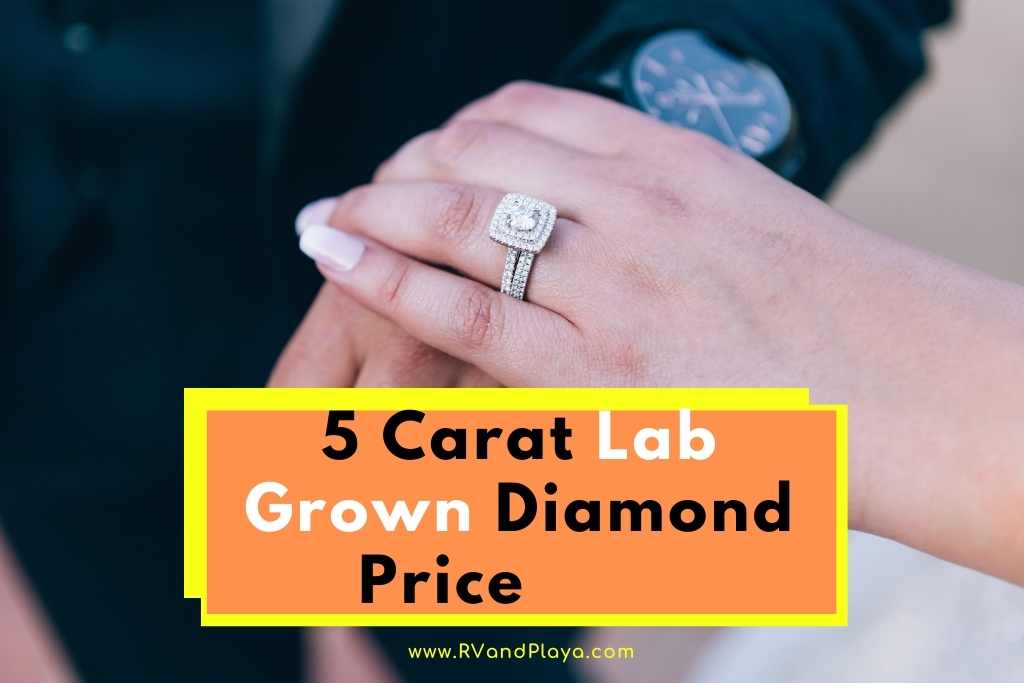In the world of diamond shopping, there are a few guidelines it’s good to know. Such as higher carat equals higher price, but lab produced diamonds are usually less expensive than naturally mined ones.
Lab produced diamonds may generally be more affordable than natural diamonds but, if you’re looking at purchasing a 5 carat lab created diamond, be prepared to shell out $5,000 or more…and that’s just for the most basic cuts and quality.
For more information on 5 carat lab diamond pricing, read on.
Table of Contents
What Is The Average Price For a 5 Carat Lab Grown Diamond?
When it comes to the pricing for any form or size synthetic diamond, variations in the market can make it tricky to evaluate exactly how much a 5 carat stone is valued at.
However, the current rule of thumb suggests that lab diamonds have an average price of between $800 and $1000 per carat.
Based on this information, a 5 Carat Lab Grown Diamond would average between $4000 and $5000 total.
The table below shows some prices that can be found looking online:
| Cut | Clarity | Color | Price | ||
|---|---|---|---|---|---|
| Round – Excellent | VS2 | G | Y – IGI | The Art of Jewels | $15,225 |
| Round – Super Ideal | VS1 | E | Y – IGI | Brilliance | $36,910 |
| Cushion – Ideal | SI1 | H | Y – IGI | Grown Brilliance | $9,950 |
| Asscher – Excellent | VS1 | H | Y – IGI | Grown Brilliance | $11,730 |
This is just a small sample of prices available from online retailers.
Individual retailers and labs used for certification can also influence the price, this can give you a good idea of what sort of price range you’re looking at if you’re seeking a 5 carat stone, though you should be aware these are prices for loose stones, not finished jewelry.
Read also >> 2.5 Carat Lab Grown Diamond Price (Current Price)
Read also > > Lab Grown Diamonds Price and Value (All You Need to Know)
Read also >> What Is A Lab Grown Diamond Called? (All You Need To Know)
Are Lab Produced Diamonds Real Diamonds?
Lab generated stones – also called synthetic or man-made diamonds – are still considered real diamonds. They pass every test made for diamonds.
In terms of composition, man-made diamonds are identical to natural diamonds – pure carbon compressed under extreme heat and pressure.
Are Lab Grown Diamonds Really Simulated or Artificial Diamonds?
Lab grown diamonds are not simulated diamonds and have a number of differences. Lab grown diamonds are still pure carbon, with few, if any, added elements.
Simulated or artificial diamonds are usually made of cubic zirconia or moissanite. It’s a different elemental composition.
How Can You Identify the Differences Between a Synthetic Diamond and a Natural Diamond?
There are usually no obvious physical indicators of differences between lab grown and natural diamonds. The same is true of the chemical composition.
Some labs etch a number or inscription on the girdle of the stone, which can be found using 20x to 30x magnification.
Other possible identifications include:
– Magnetic tests: Some lab diamonds have small traces of magnetic residue formed by the HPHT process. Testing can demonstrate the lingering magnetic effects.
– Ask a Jeweler: Jewelers have several methods of testing, including
- Use of an IIa Testing machine
- Fluorescence testing
- Microscopic examination of growth patterns.
- Phosphorescence can sometimes occur in lab diamonds, due to residue from the process of formation.
Note:
It’s pretty much impossible for regular individuals to determine any differences between a lab produced diamond and a natural diamond. It takes a high tech lab or at least a strong microscope to differentiate between the two diamonds.
Are Lab Grown Diamonds Certified?
Lab grown diamonds are certified with the same standards and grading as natural diamonds.
Synthetic or lab generated Diamonds are graded using the GIA grading standards of Carat Weight, Color, Cut and Clarity.
What Determines The Final Value of a 5 Carat Lab Grown Diamond?
The value of a lab created diamond is determined through the same methods as are used for a natural diamond – Carat Weight, Color, Cut, and Clarity
In addition, some consideration is given to the question of rarity. One reason lab grown diamonds are usually less expensive than natural diamonds is that they take less time to form and are far less rare.
Aside from that considerations include:
Carat Weight:
Carat weight is a big factor in evaluating the value of any diamond. At 5 carats, the value of a lab grown diamond of this size has a correspondingly large price tag.
Color:
The closer a 5 carat diamond is to being completely colorless, the greater the value.
On a scale from D to Z, D to F are considered extraordinarily rare (and expensive). The best value comes from diamonds with a color grade G to I, where the diamond is close enough to colorless to provide the ‘white diamond’ sparkle, but more affordable due to slight tinting.
Clarity:
Clarity measures flaws and inclusions and their resulting impact on the visual effect of the diamond, as well as their impact on the diamond’s structural integrity.
At 5 carats, there’s a lot of potential for inclusions and flaws. Diamonds with fewer inclusions are worth exponentially more.
Flawless diamonds are incredibly rare, even with lab controls involved in production. That’s why the best value is usually for VS1 or VS2 gems.
These stones have some flaws visible to a microscope, which makes them more affordable, but to the naked eye they appear pristine (also known as eye-clean)
Cut:
The more involved and precise the cut, the greater the value. A round cut is considered the most popular, but also the most difficult to produce as an Ideal or Excellent cut, with 57 facets.
Cuts are judged not only by complexity but by precision and adherence to optimum angles for refraction and sparkle.
With a 5 carat stone, getting the proper cut with techniques designed for smaller stones can be trickier than it sounds.
Why Are 5 Carat Lab Grown Diamonds So Expensive?
There are three reasons why 5 carat diamonds, including synthetic diamonds, are so expensive
- Cost of manufacture
- Odd size = low demand
- Big diamond = fewer resources.
Cost of Manufacture:
Creating lab diamonds – of any size – is an expensive process. It takes special equipment, and a team of experts to produce diamonds that are marketable.
The larger the diamond, the greater the potential for mistakes. A 5 carat of poor quality isn’t marketable as such.
It also takes a lot of time – the larger the diamond, the longer it takes.
Time, labor, and equipment costs all have to be factored into the diamond price.
Odd Size – Low Demand:
Most people, if they’re looking for a larger diamond for jewelry, are looking for a 1 carat, maybe a 2 carat, stone.
Requests for stones larger than 2-3 carat in retail are exceedingly rare.
Big Diamond – Fewer Resources:
How many rings of ordinary size could you make out of a 5 carat stone?
When most rings use diamonds between 0.25 and 2 carats, the answer is probably a minimum of 3, or 2 if there’s a significant amount of lost mass from cutting.
The pricing takes this into account, offset by any resources saved from the lesser cutting time.
How Do Prices For Lab Grown 5 Carat Diamonds Compare to Naturally Mined Diamonds?
Lab grown diamonds are almost always lower in price than their natural counterparts. For example 1 carat stones from James Allen:
- Lab Grown: $3,640
- Natural Mined: $5,280
Doing a comparison of different online offers, we can find prices like this:
- Asscher Cut 5.25 Carat Lab Diamond for $24,122
- Asscher Cut 5.4 Carat Natural Diamond for $152,700
This first is from Rare Carat, the second from James Allen, but the Carat Weight, Clarity, Cut and Color are close enough for a comparison to be valid.
Do 5 Carat Lab Grown Diamonds Retain Their Value?
Lab grown diamonds, as of now, have little to no resale value. The reproducibility of these diamonds makes them less valuable in the secondary market.
Even a 5 carat stone is unlikely to maintain a high value after the initial sale. It might potentially be more profitable to have the stone cut into smaller stones, reset, and sold as new, smaller pieces of jewelry
What Are 5 Carat Lab Grown Diamonds Used For?
5 carat stones can be used for whatever purpose you want. They might be considered a bit large for earrings.
The most popular choice for these stones is for use as the central stone in high end engagement rings.
James Allen is the leader in online diamond sales. Their imaging technology is the same as inspecting a diamond with a jeweler's loupe. They have the largest exclusive loose diamond inventory online and fantastic prices.
They also have the nicest collection of lab created diamonds online. Save 10% off select lab grown diamonds and 25% off ring settings during limited time sale!
WHAT WE LOVE ABOUT THEM:
- No questions asked returns within 30 days of shipment. James Allen will send you a paid shipping label to return the ring.
- Lifetime Warranty
- Free International Shipping
- Free prong tightening, repolishing, rhodium plating and cleaning every 6 months
- Provide insurance appraisals
- One free resizing within 60 days of purchase
- Free ring inscriptions
- Best-in-class high quality imagery of all diamonds in stock
- 24/7 Customer Service
- Best-in-class packaging
Final Thoughts
When it comes to diamonds, lab grown diamonds are often more affordable than their natural counterparts.
However, if you’re looking for a large stone – like a 5 carat or greater – then even a lab grown diamond can cost several thousand dollars.
References
https://www.withclarity.com/education/diamond-education/diamond-carat/lab-diamond-carat-and-cost
Recent Posts
Shopping for diamonds is a tricky business and trying to find something of significant size can become almost impossibly expensive. If you want to find some more affordable options, then you will...
When you're shopping for diamonds on a budget, you may be looking at lab created diamonds as a more affordable option than their naturally formed options. But with all the man-made options out...


